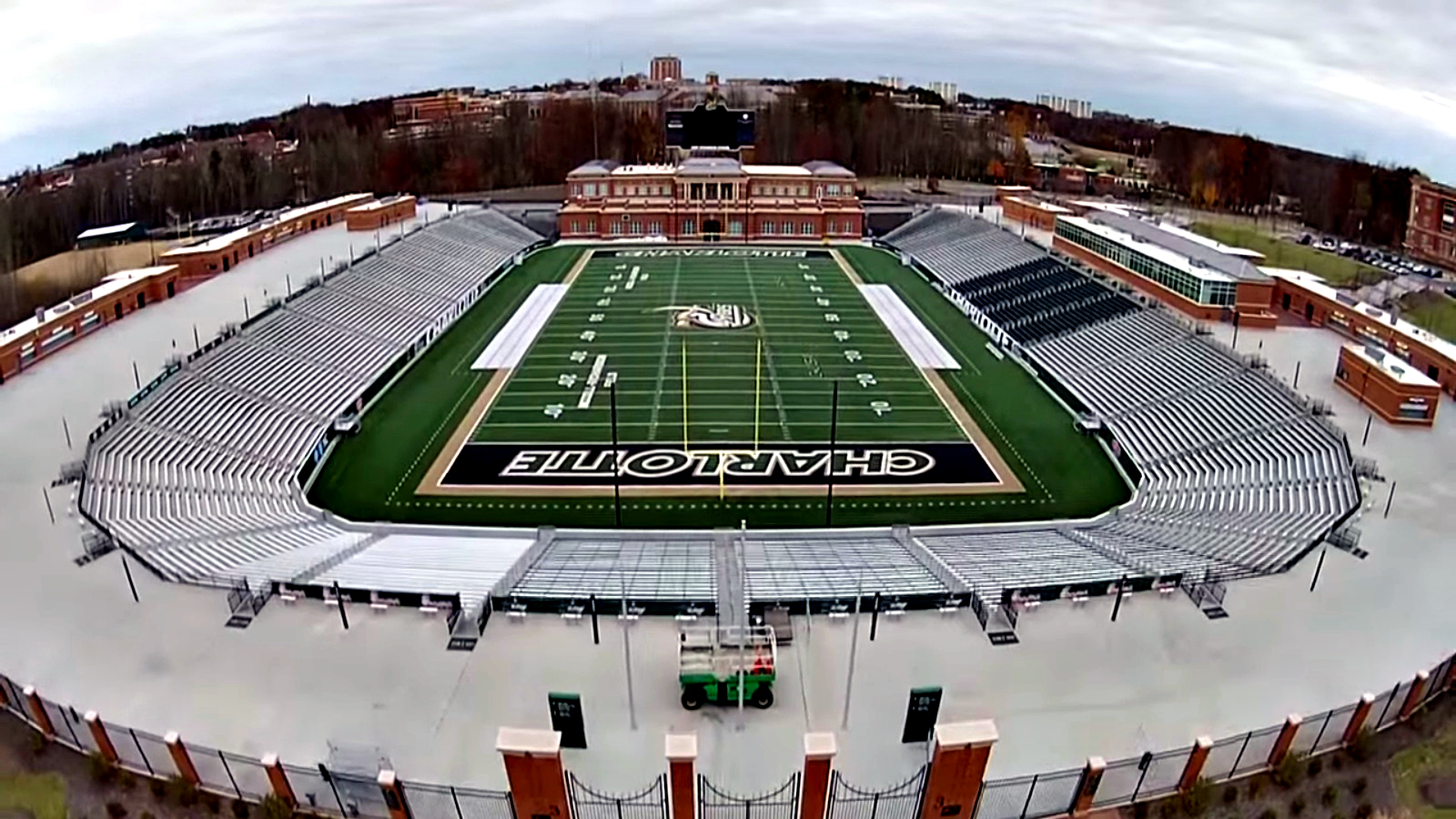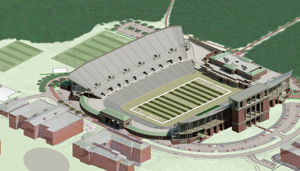Deleted
Deleted Member
Posts: 0
|
Post by Deleted on Oct 11, 2017 19:30:53 GMT -6
UNC Charlotte's Jerry Richardson Stadium  They just built a temporary 15,300 seat bowl to get started. Their goal over time is to build out to 40,000 permanent seats. The initial cost for what you see was $45 million. They must've done considerable foundation work to support the future expansion with that price tag. |
|
|
|
Post by gocardsgo on Oct 11, 2017 23:21:02 GMT -6
My guess is that's meant to be the concourse under the second level when they get up to 40,000? But then what do you do with the building on the right sideline? It's set a little too far back to have seats built over the top of that I feel like. I love the building in the far endzone though. I'd almost rather see Ball State do something like that than what they currently have in the south endzone.
|
|
|
|
Post by DickHunsaker on Oct 12, 2017 6:19:13 GMT -6
I like that stadium. A little unusual but good on the eyes
|
|
|
|
Post by Lurkin McGurkin on Oct 12, 2017 6:58:17 GMT -6
Not sure why they spent 45 mill for that, when they could have planned it out better for future expansion.
Would have been much cheaper if they played at American Legion Stadium in Charlotte proper while they built a permanent grandstand. Sure, it's off campus, but it seems like they are wasting tens of millions this way.
|
|
Deleted
Deleted Member
Posts: 0
|
Post by Deleted on Oct 12, 2017 7:12:59 GMT -6
Not sure why they spent 45 mill for that, when they could have planned it out better for future expansion. Would have been much cheaper if they played at American Legion Stadium in Charlotte proper while they built a permanent grandstand. Sure, it's off campus, but it seems like they are wasting tens of millions this way. I think a large portion of that cost was initial foundation work for the 40,000 seat expansion. They did it early. To go back later and dig to retrofit the foundation would be more expensive, IMO. When Buffalo, NY built their minor league baseball stadium in 1986 they spent $42 million, expensive for a minor league stadium in the '80s. Their plan was to eventually get an MLB franchise, so they built the minor league facility with oversized foundation work, so the 18,000 seat stadium could be expanded to 45,000 seats. Going back and digging and retrofitting the foundation can be expensive. They ate the cost early to save money later. Except their chances of an MLB franchise are nil with Cleveland and Toronto being so close. |
|
|
|
Post by Lurkin McGurkin on Oct 12, 2017 8:33:45 GMT -6
 I looked up the future plans, and I see how they are wanting to do it. Makes more sense when you see that part. |
|
|
|
Post by 00hmh on Oct 12, 2017 11:19:04 GMT -6
Well, that makes sense if you think they can support football, and that they need 40K seats. That would be more than twice the number they are drawing now, and would not really be up to major conference standards, if that is their dream.
They are reporting attendance around 18K, not bad, but that still might mean they should have built the thing to seat 25K originally, not 15K.
I'm not sure this whole story is that convincing a tribute to good planning.
|
|
Deleted
Deleted Member
Posts: 0
|
Post by Deleted on Oct 12, 2017 12:30:30 GMT -6
Well, that makes sense if you think they can support football, and that they need 40K seats. That would be more than twice the number they are drawing now, and would not really be up to major conference standards, if that is their dream. They are reporting attendance around 18K, not bad, but that still might mean they should have built the thing to seat 25K originally, not 15K. I'm not sure this whole story is that convincing a tribute to good planning. Research Triangle (Duke, NC State, UNC) are 2.5 hours away. USC is 90 minutes away. The Charlotte Metro area has 2.5 million people and 28k students. With on-field success, they will fill a 40k stadium. Look at UCF. They compete for fans with Florida, FSU, Mami, and some with USF. Orlando Metro has 2.5 million people and the campus is large (65k students). They built a 45k stadium, and average about 30-35k per game. UCF Spectrum Stadium is designed to expand to 56k, and then to 65k. |
|
|
|
Post by 00hmh on Oct 12, 2017 12:53:00 GMT -6
I guess that is the big advantage, maybe a big local alumni base. But, they are C-USA. Can't be that big a draw, and competing with ACC for the casual fan. TV games tough to beat, too.
No idea, maybe it's a cheap ticket, big family draw?
|
|
Deleted
Deleted Member
Posts: 0
|
Post by Deleted on Oct 12, 2017 12:54:42 GMT -6
I guess that is the big advantage, maybe a big local alumni base. But, they are C-USA. Can't be that big a draw, and competing with ACC for the casual fan. TV games tough to beat, too. No idea, maybe it's a cheap ticket, big family draw? UCF was C-USA (when Spectrum Stadium was built), and moved to AAC (still non Big 5), and competed against two ACC programs and an SEC programs. Sounds very familiar to Charlotte. Your break-even point isn't at sell out attendance. |
|
|
|
Post by 00hmh on Oct 12, 2017 12:59:43 GMT -6
I guess that is the big advantage, maybe a big local alumni base. But, they are C-USA. Can't be that big a draw, and competing with ACC for the casual fan. TV games tough to beat, too. No idea, maybe it's a cheap ticket, big family draw? UCF was C-USA (when Spectrum Stadium was built), and moved to AAC (still non Big 5), and competed against two ACC programs and an SEC programs. Sounds very familiar to Charlotte. Your break-even point isn't at sell out attendance. Are you sure that breakeven covers the investment cost? Usually, attendance doesn't cover operating expenses, even big schools. I doubt a big TV contract here, either. What is the ROI on the 45M? There was a naming gift to help build it, and it does produce a lot of revenue to the alumni fund through the seat licensing. It's never really clear, what real revenue and expenses are. Usually the Income Statement for college sports is nothing like the real expenses of the athletic activities. Quick look on the web, their total athletic budget is not greatly different than ours. 10/15% higher expenditures on operations. They have greater attendance than we do, so more revenue, and have a seat license fee for season tickets which is not revenue goes to the alumni fund. Good seats, $2500 up front, plus annual fee, plus $190 for a ticket. The alumni fund and naming gifts are the investment side separate from operations. So this license money contributions total looks pretty good, except of course that the alumni who spend on the football, in its absence might have built a library or funded scholarships and so on. And it's not For 2010-2014 subsidies to cover operating losses in athletics at UNC-Charlotte were $85,854,522 of its $116,678,876 total spending (or 74 percent) since 2010. Student fees comprise nearly three-fourths of those subsidies, adding up to $64,390,891 over the last four years. Certainly biggest budget item in expenses is football of course, biggest revenue item,too, very likely the biggest operating deficit...numbers of scholarships, coaching salaries, travel, game day, all that. |
|
|
|
Post by Lurkin McGurkin on Oct 12, 2017 14:33:43 GMT -6
I guess that is the big advantage, maybe a big local alumni base. But, they are C-USA. Can't be that big a draw, and competing with ACC for the casual fan. TV games tough to beat, too. No idea, maybe it's a cheap ticket, big family draw? UCF was C-USA (when Spectrum Stadium was built), and moved to AAC (still non Big 5), and competed against two ACC programs and an SEC programs. Sounds very familiar to Charlotte. Your break-even point isn't at sell out attendance. UCF was also playing in the city-owned Citrus Bowl, which held 52K at the time. Renting a stadium for the day (at rates that were pretty low, I'd imagine) is way cheaper than building your own. So they started with a big stadium, and big expectations, with low costs. |
|